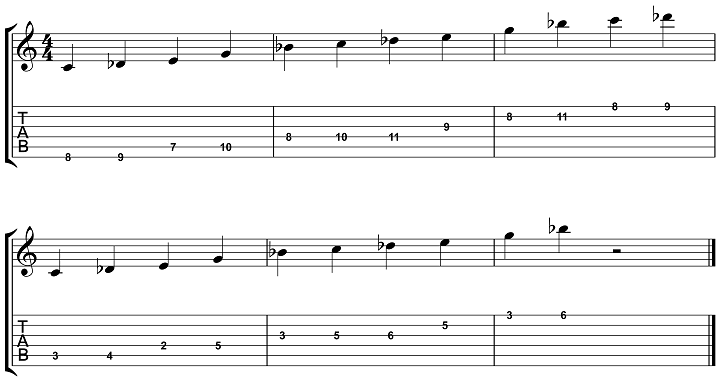Printable Version of Topic
Click here to view this topic in its original format
GMC Forum _ THEORY _ What Are 7b9 Pentatonic Scales
Posted by: The Professor Jun 13 2013, 09:13 AM
What Are 7b9 Pentatonic Scales
Usually the first scale that pops to mind when you see a 7b9 chord symbol is the Diminished Scale, or the 5th Mode of Harmonic Major. While these are great first-choice scale to use when soloing over 7b9chords, sometimes you want a smaller scale shape to play with over this chord in your improvisations.
This is where the 7b9 Pentatonic Scale comes in.
In this lesson, we’ll take a look at the theory behind the 7b9 Pentatonic Scale, how it is built, how to apply it to your soloing and a few common fingerings that you can explore in the practice room.
How to Build a 7b9 Pentatonic Scale
The 7b9 Pentatonic Scale is built from the following interval pattern.
Root - b2 - 3 - 5 -b7
You can see these notes laid out in tab and notation for an C 7b9 Pentatonic Scale here.

You can also think of the 7b9 Pentatonic Scale as being an alteration of the Mixolydian Pentatonic Scale.
If you have a C Mixolydian Pentatonic Scale, C D E G Bb, and you lower the 2nd note, C Db E G Bb, you now have a C 7b9 Pentatonic Scale.
To apply this scale in a soloing situation, you can use the 7b9Pentatonic Scale over major, 7th, 7b9 and 13b9 chords.
2 Common 7b9 Pentatonic Scale Fingerings
To help get you started, here are two common fingerings for the C 7b9 Pentatonic Scale, one with a 6-string root, and one with a 5-string root.
Try memorizing these scales in the key of C first, then take them to the other 11 keys around the neck as you expand on these scale shapes in your guitar practice routine.

7b9 Pentatonic Scale Practice Guide
To finish up, here are a number of ways that you can practice 7b9 Pentatonic scales in order to get the fingerings, and theory, behind these scales under your fingers and into your guitar playing.
1. Sing the root note, C for example, and play the corresponding 7b9 Pentatonic Scales over that root.
2. Play a root note on the guitar, C for example, and then sing the corresponding 7b9 Pentatonic Scale over that root note.
3. Say the note names, or interval numbers, such as C Db E G Bb or 1 b2 3 5 b7, as you play and sing the notes in the above exercises.
4. Put on a static vamp, C, C7b9, C7 or C13b9 for example, and practice soloing over those chords using the related 7b9 Pentatonic Scale as the basis for your solo.
5. Repeat any/all of the above exercises in all 12 keys.
Do you have a question or comment about 7b9 Pentatonic Scales? If so, share them in the comments section below this thread.
Posted by: AK Rich Jun 15 2013, 09:22 PM
5th mode of Harmonic Major? I had no idea there was such a scale. Can you tell us more about this scale and the modes thereof?
Or have you already and I missed it? Thanks Matt!
Posted by: The Professor Jun 16 2013, 08:42 PM
5th mode of Harmonic Major? I had no idea there was such a scale. Can you tell us more about this scale and the modes thereof?
Or have you already and I missed it? Thanks Matt!
Or have you already and I missed it? Thanks Matt!
Hey, we haven't covered this mode yet in this series, but we will be looking at it shortly!
Simply put, the Harmonic Major Scale is a major scale with a b6, so in C it would be C D E F G Ab B C.
When you start on the 5th note, you get the 5th mode, G Ab B C D E F G, or a Mixolydian Scale with a b2(b9).
This is a great scale to check out if you want to bring a b9 sound to your 7th chord lines.
More to come!
Powered by Invision Power Board (http://www.invisionboard.com)
© Invision Power Services (http://www.invisionpower.com)
